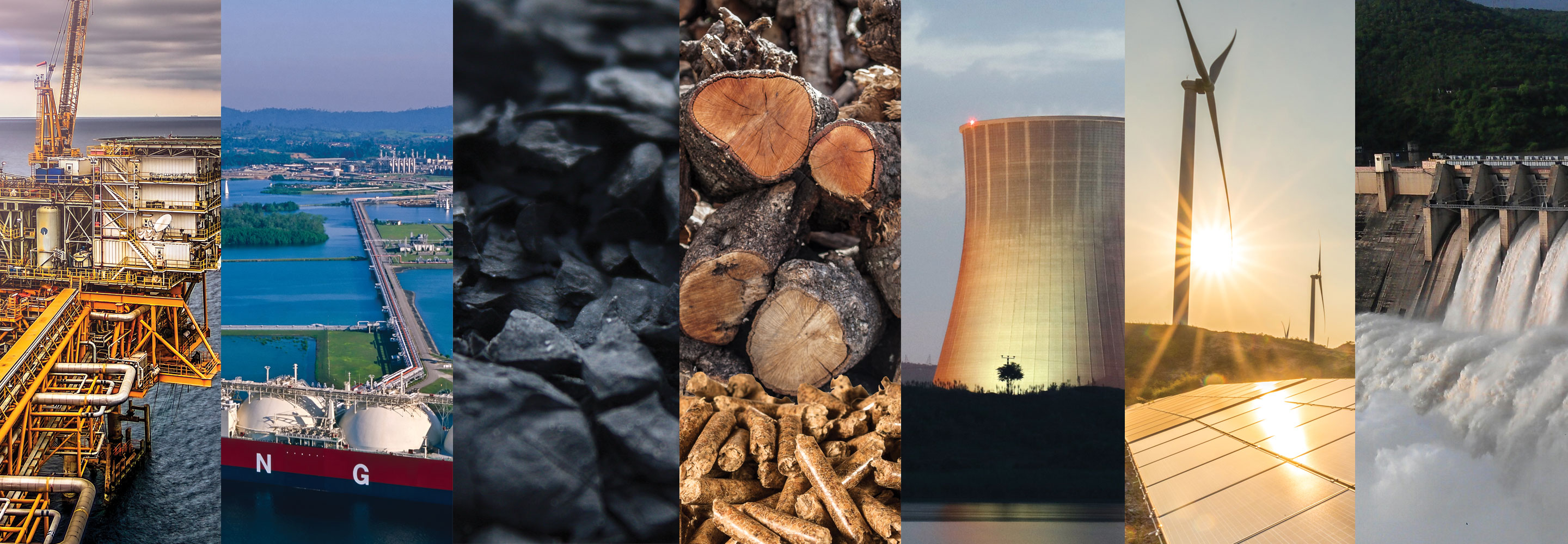
Energy supply
In this article
Projections
Energy supply evolves to meet demand projections
2050 global demand by fuel – Quadrillion Btu
2050 global demand by fuel – Quadrillion Btu
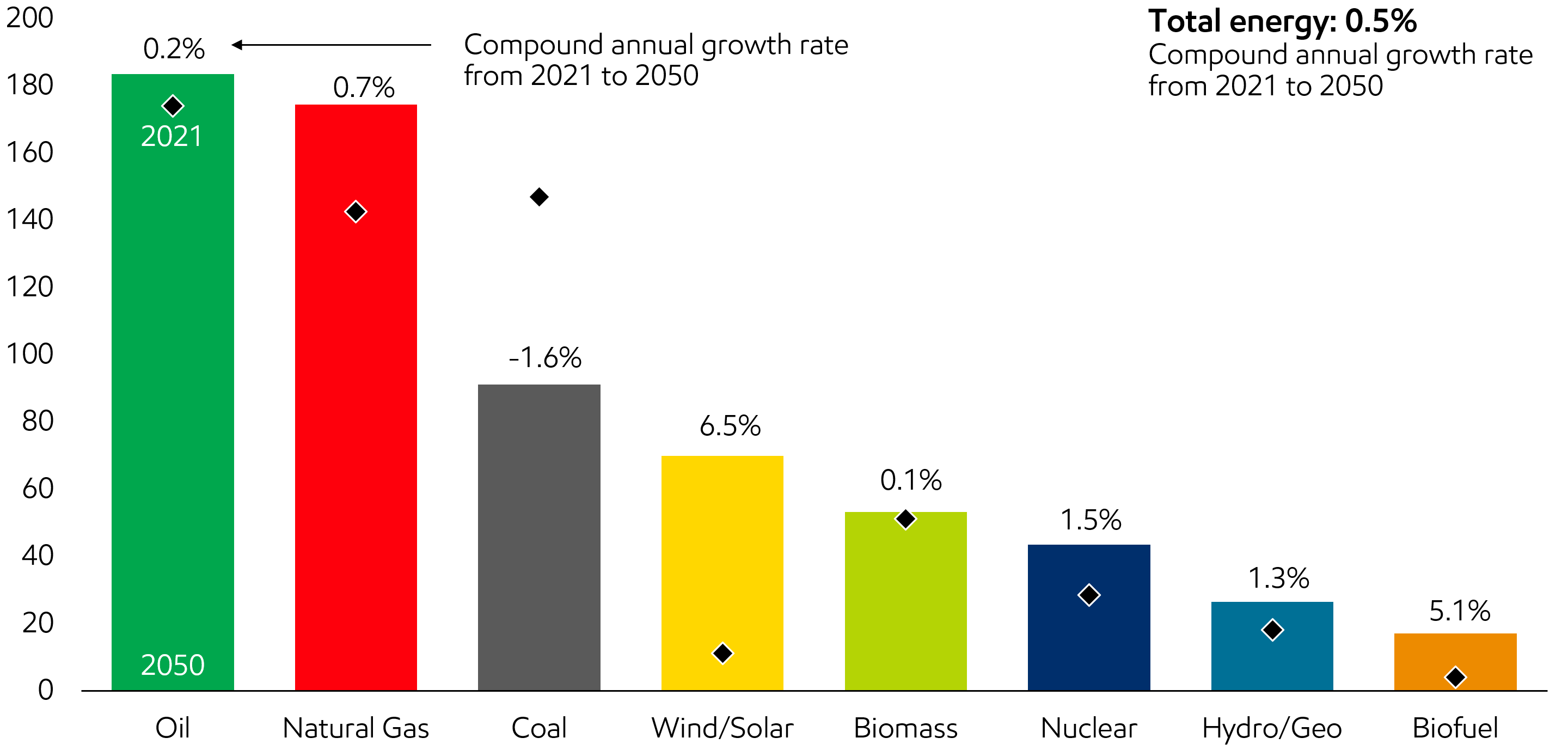
- Most lower-emission energy sources, including nuclear, wind/solar, and biofuels, increase at the fastest pace.
- Oil remains the largest source of primary energy, as it is essential for commercial transportation and chemicals.
- Natural gas demand rises, largely to help meet increasing needs for electricity and lower-emission industrial heat.
- Coal is still prominent in some non-OECD countries, although global consumption appears to have peaked in 2014.
Global energy supplies vary by sector
End-use energy - quadrillion Btu

- The energy mix will vary by sector to meet rising demand while addressing environmental impacts.
- Oil remains essential for transportation, as growing commercial transportation still relies on liquid fuels to meet more than 80% of demand in 2050.
- With a drive for cleaner and more efficient operations, the industrial sector relies primarily on electricity and natural gas for growth. Industrial oil demand grows as a feedstock for chemicals, asphalt, lubricants and other specialty products.
- Electricity demand rises in all end-use sectors. The mix of fuel supply to generate electricity shifts to lower-emission sources.
Liquids
Liquids are projected to remain the world’s leading energy source in 2050, even as demand growth slows beyond 2025.
Commercial transportation and chemicals – sectors where liquid fuels are favored for their high energy density and distinctive chemical properties – drive liquids demand growth. Overall, demand for liquids is expected to rise by about 15 million barrels per day by 2050. Almost all the growth will come from the emerging markets of Asia, Africa, the Middle East, and Latin America.
New investments in oil production – and in technologies to improve recoverability, enhance efficiency and reduce cost – are needed to offset natural production decline and meet rising demand. Much of the growth in liquids production is expected to be from sources of supply that have been unlocked by technology advances in the past two decades: North American tight oil and the natural gas liquids associated with unconventional oil and natural gas production, and deepwater projects offshore Brazil and Guyana, for example.
Continued investment in conventional crude and condensate will also be needed. The Middle East and Russia/Caspian remain significant oil producers.
Liquids demand driven by transportation and chemicals
By region and sector – Million of oil-equivalent barrels per day

- Global liquids demand growth is concentrated in developing nations. Asia Pacific will account for about 60% of global growth by 2050.
- Efficiency gains and fuel switching in Europe reduce liquids demand by 35% from 2021 to 2050, led by a reduction of about 75% in light-duty vehicle liquids demand.
- Chemicals and commercial transportation account for almost all of the liquids demand growth, with chemicals expected to increase by around 80% from 2021 to 2050 and commercial transportation to increase by approximately 45%.
Liquids supply highlights the need for investment
Global liquids supply by type – Million of oil-equivalent barrels per day
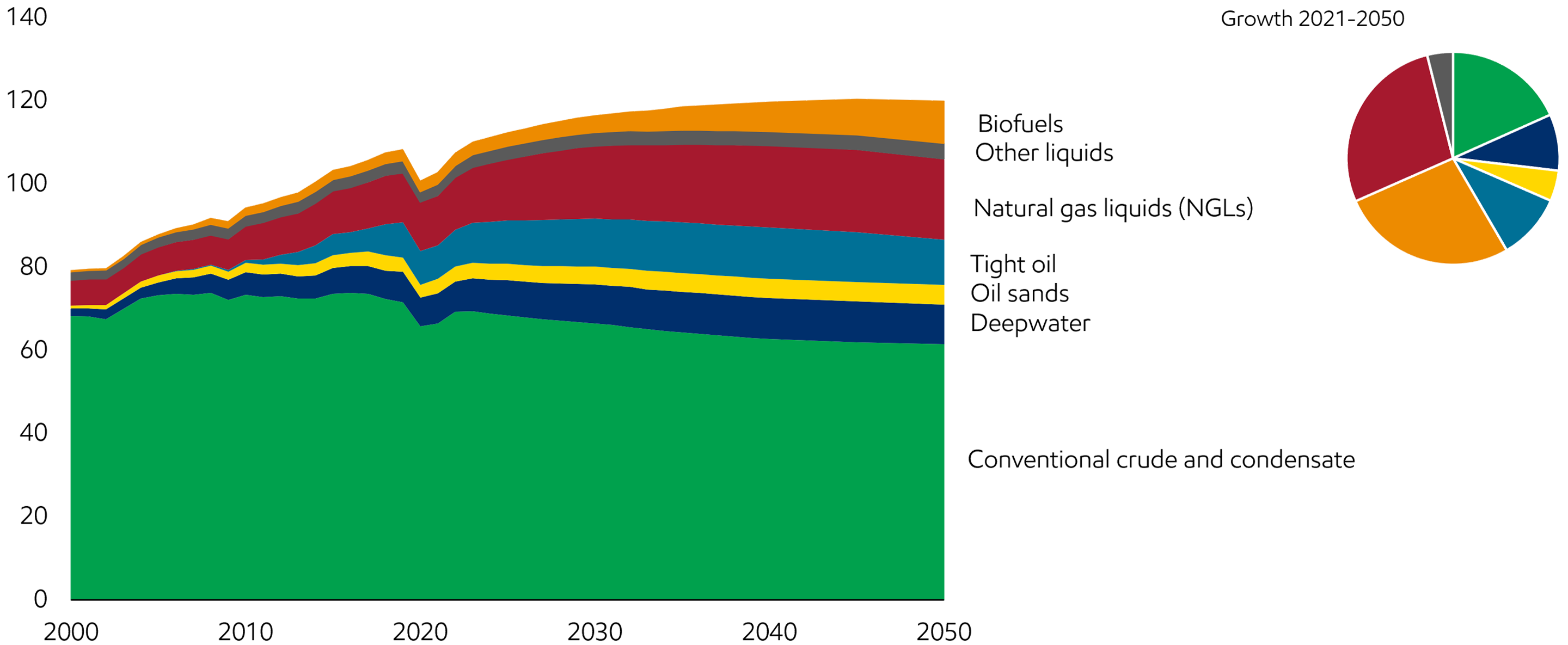
- The natural decline rate of existing oil production is approximately 7% per year. Significant investment is needed to offset this decline and meet the projected demand growth.
- In 2021, conventional crude and condensate made up about two-thirds of the liquid supply. By 2050, new investment is expected to have diversified oil supply such that only about half of liquids will come from these conventional sources.
- Tight oil is also rich in natural gas liquids, so tight oil growth brings significant new supplies of NGLs.
- Biofuels almost quadruple with increasing demand for lower-emission liquid fuels and technology advancements that reduce costs and land use.
- North America tight oil and associated NGLs production increases by about 50% from 2021 to 2030. This significant growth solidifies North America as a net exporter of liquids.
- The Middle East continues to invest in conventional oil production to maintain their role as leading exporters, which account for about 70% of their production in 2050.
- Asia Pacific remains the largest and fastest-growing region for liquids demand, and increasingly relies on imports.
- Biofuels production grows across all continents to about 10 million barrels per day in 2050 to address emissions from hard-to-abate end use.
Liquids supply highlights regional diversity
By region and type – Million of oil-equivalent barrels per day
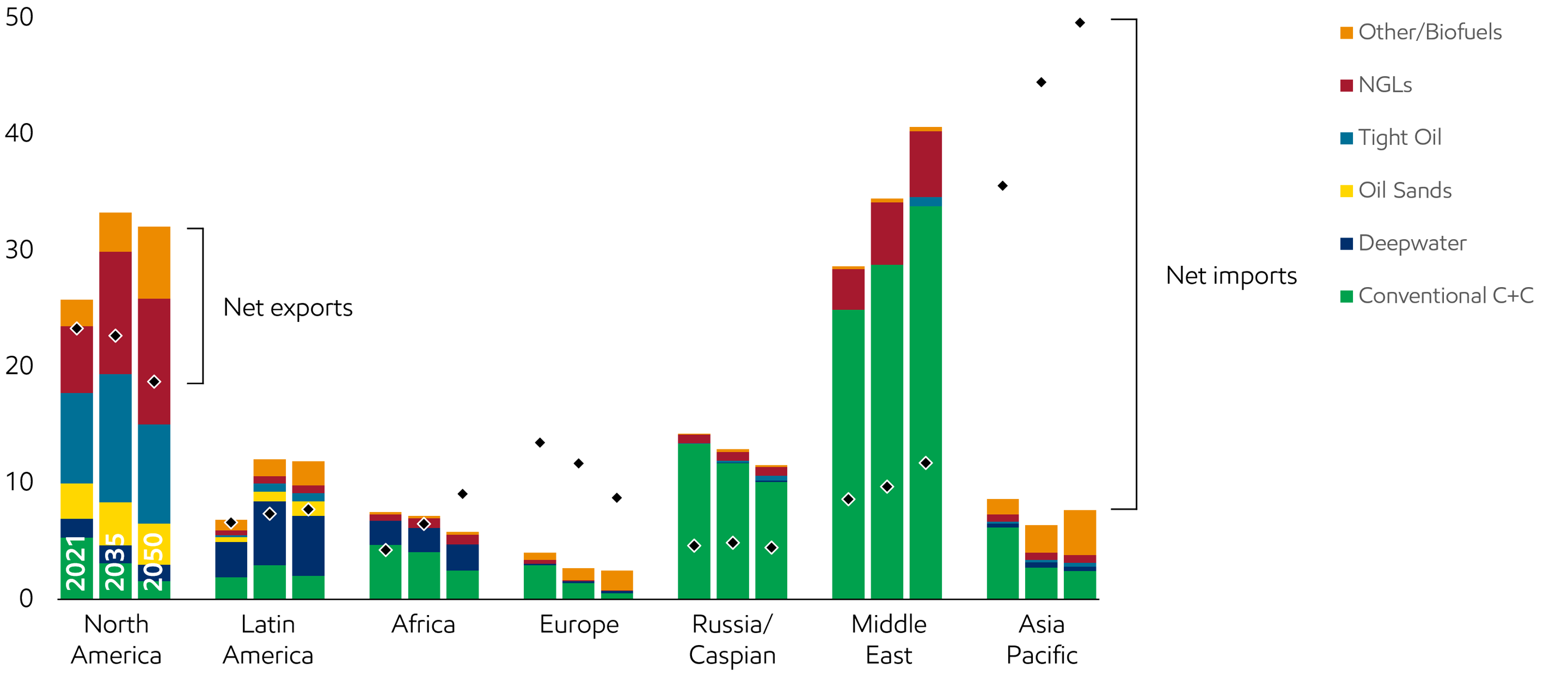
- North America tight oil and associated NGLs production nearly doubles between 2017 and 2025. This significant growth swings North America to a net exporter of liquids
- After 2025, new deepwater supplies from Latin America and conventional crude from the Middle East grow to meet global demand
- The Middle East and Russia/Caspian will continue to invest in conventional oil production to maintain their role as leading exporters, at about two-thirds of their production in 2040
- Asia Pacific remains the largest and fastest growing region for liquids demand, and relies on increasing imports to supply the strong demand
Natural gas
Natural gas plays a vital role in satisfying the energy needs of consumers worldwide while helping to mitigate the risks of climate change.
Choosing natural gas as a lower-carbon alternative to coal improves air quality and reduces carbon intensity.
Natural gas is abundant and versatile. It is a reliable and flexible fuel for electricity generation and a lower-carbon industrial fuel. It’s also convenient for home use.
Natural gas resources are geographically and geologically diverse. North America’s unconventional gas resources are produced by applying horizontal drilling and hydraulic fracturing technologies. The Middle East and Africa are expected to tap large conventional natural gas resources. Natural gas production is expected to grow in every region except Europe and Russian Caspian.
Natural gas trade is a critical link between resource-rich regions and demand centers in Asia Pacific and Europe. New liquefied natural gas export projects are expected to diversify the market and meet about 50% of the growth in natural gas demand to 2050.
Natural gas grows in industry, electricity generation, and transportation
World – Billion cubic feet per day
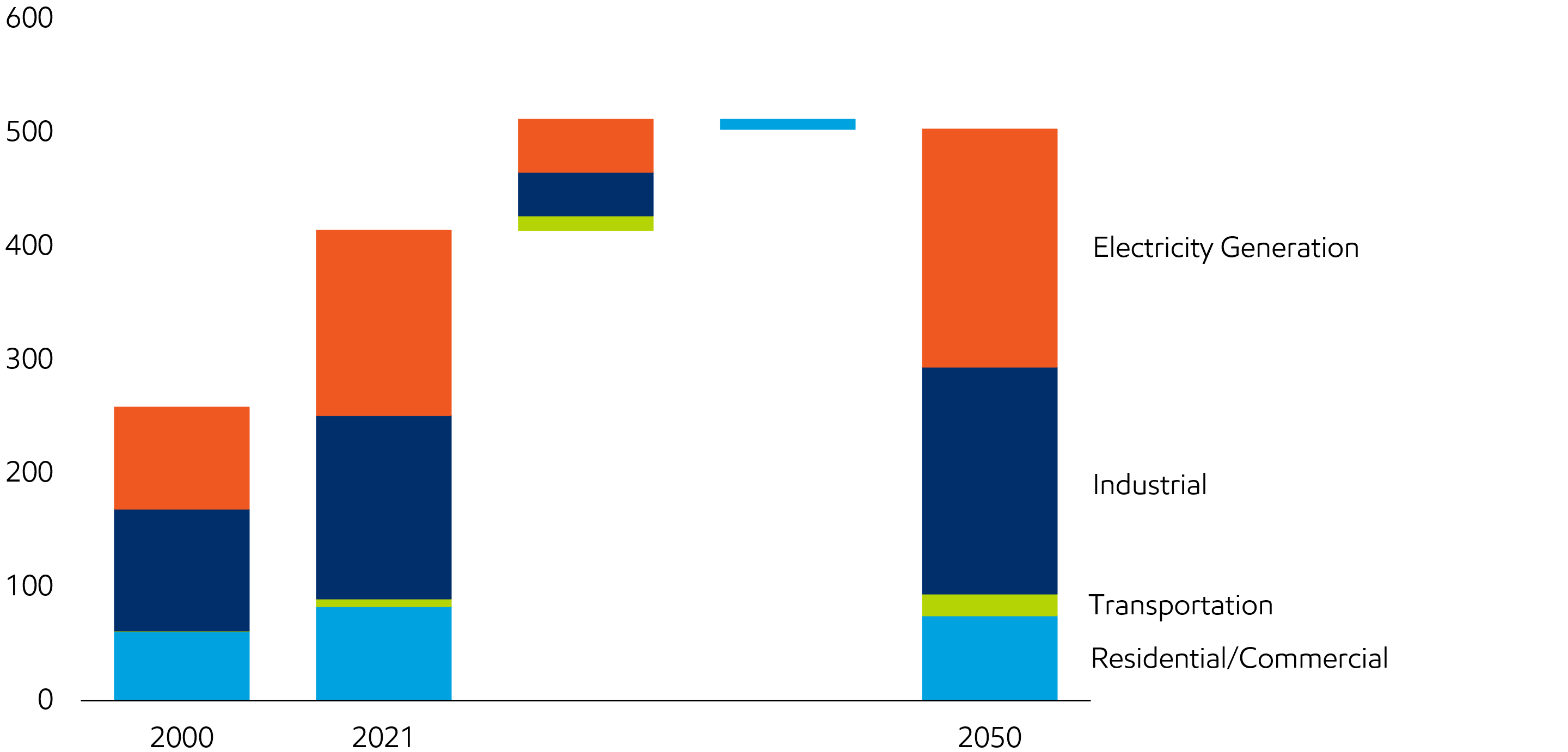
- Natural gas plays a vital role in satisfying the energy needs of consumers worldwide while helping to mitigate the risks of climate change.
- Choosing natural gas as a lower-carbon alternative to coal improves air quality and reduces carbon intensity.
- Natural gas is abundant and versatile. It is a reliable and flexible fuel for electricity generation and a lower-carbon industrial fuel. It’s also convenient for home use.
- Abundant and convenient, on an absolute basis natural gas grows more than any other single source of primary energy during the Outlook period.
- About half of the growth in natural gas demand is for electricity generation, and 40% is for industrial use.
- Residential users rely on natural gas for heating and cooking.
- Increased penetration of natural gas-fueled buses and trucks can help urban areas manage air quality.
Natural gas is growing, but coal is still predominant in non-OECD Asia
2050 - Quadrillion Btu

- Natural gas rises in prominence as a cleaner-burning alternative to coal over the Outlook period.
- In China and other developing nations in the Asia Pacific region, natural gas demand doubles from 2021 to 2050. Coal still plays a significant role in the region.
- Coal demand grows by about 40% in developing Asia Pacific countries outside China, partially offsetting major strides to reduce the use of coal in developed countries and China.
- Outside of Asia Pacific, many developing countries are expected to leverage domestic natural gas supplies to meet rising electricity demand and fuel industrial growth.
- In 2050, coal is expected to meet about 14% of global energy demand and produce 27% of energy-related CO2 emissions.
- With the same boiler efficiency, burning natural gas to produce heat emits about 40% less CO2 than burning coal.
- Choosing flexible, highly efficient gas-fired electricity generation to replace older, inefficient coal plants can reduce CO2 emissions by up to 60% while producing fewer air pollutants.
- Every 1% of global primary energy shifted from coal to natural gas can reduce energy-related CO2 emissions by almost 1% in 2050.
Coal-to-natural gas switching reduces emissions
2050 – Global share
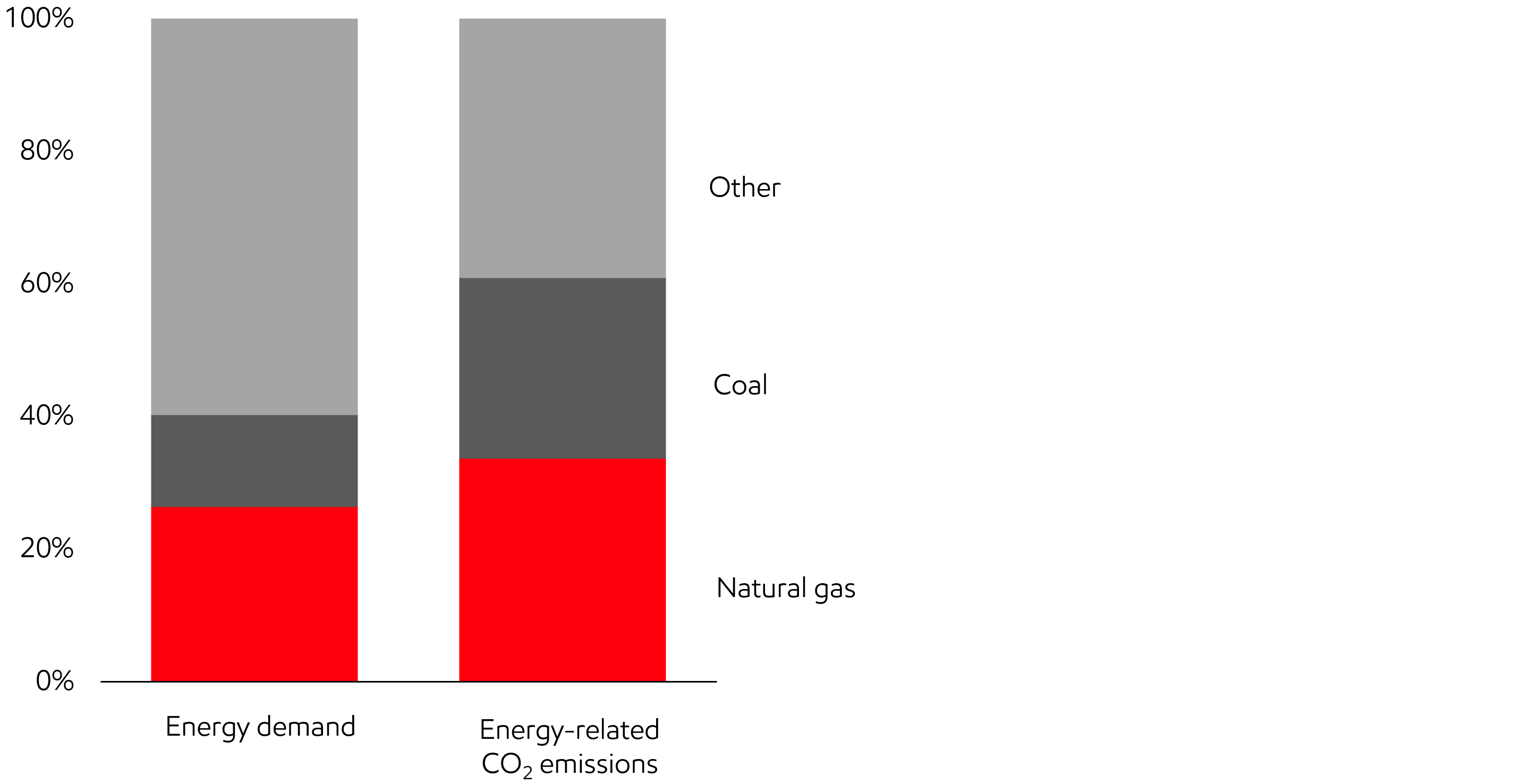
- In 2040, coal is expected to meet just 20 percent of global energy demand but produce more than 35 percent of energy-related CO2 emissions
- With the same boiler efficiency, burning natural gas to produce heat emits about 40 percent less CO2 than burning coal
- Choosing flexible, highly efficient gas-fired electricity generation to replace older, inefficient coal plants can reduce CO2 emissions by up to 60 percent while also producing fewer air pollutants
- Every 1 percent of global primary energy shifted from coal to natural gas can reduce energy-related CO2 emissions by nearly 1 percent in 2040
Gas supply diversifies and trade grows to meet rising demand
Billion cubic feet per day
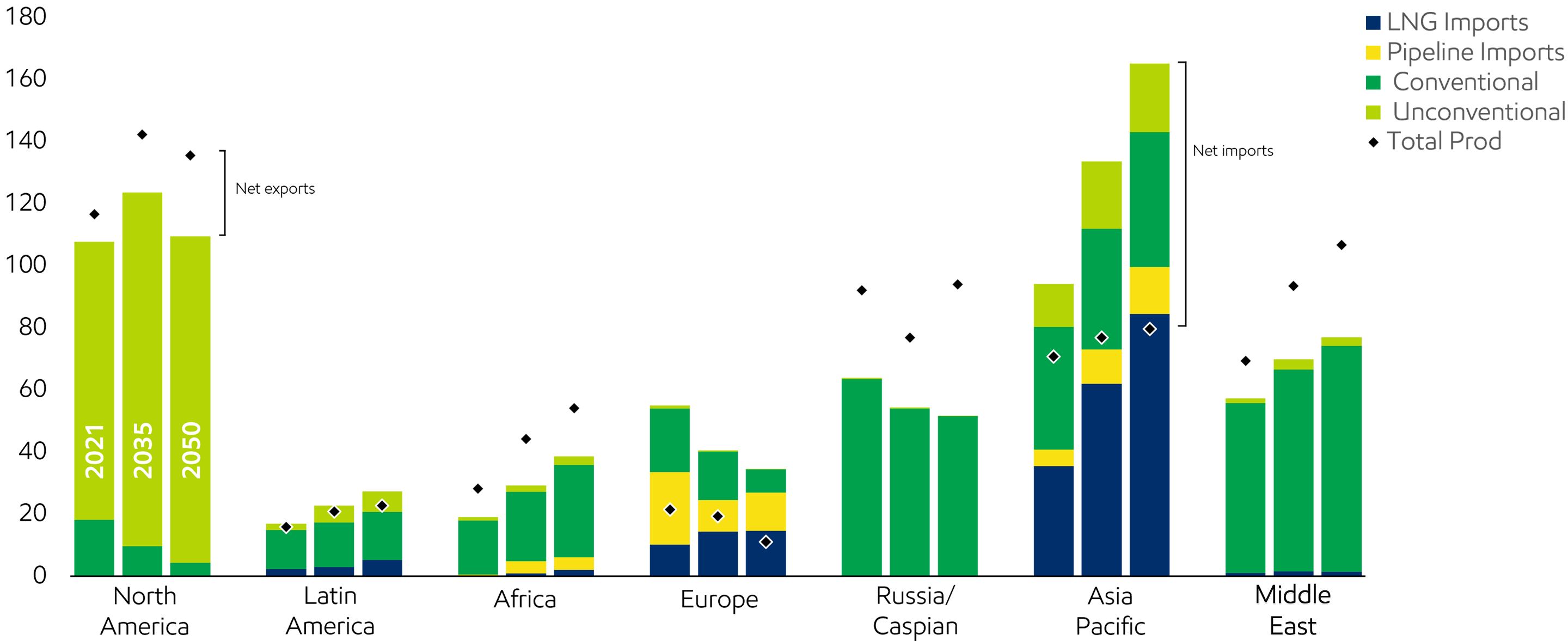
- North America’s abundant unconventional natural gas is expected to feed new LNG projects and meet growing local demand.
- Africa’s natural gas production could drive economic growth and prosperity, as demand and exports are poised to accelerate, led by Mozambique, Nigeria, Algeria and Egypt.
- The Middle East is expected to continue investing in LNG export projects, more than doubling their export capacity by 2050.
- Europe is likely to continue to rely on natural gas trade to meet consumer demand as local production declines.
- In 2021, Asia Pacific’s LNG imports were larger than all other regions’ combined; around 2030, the region’s total natural gas demand will likely surpass North America’s; and in 2050, LNG trade is expected to meet about half of Asia Pacific’s natural gas demand.
Asia Pacific and Europe benefit from LNG imports
Billion cubic feet per day
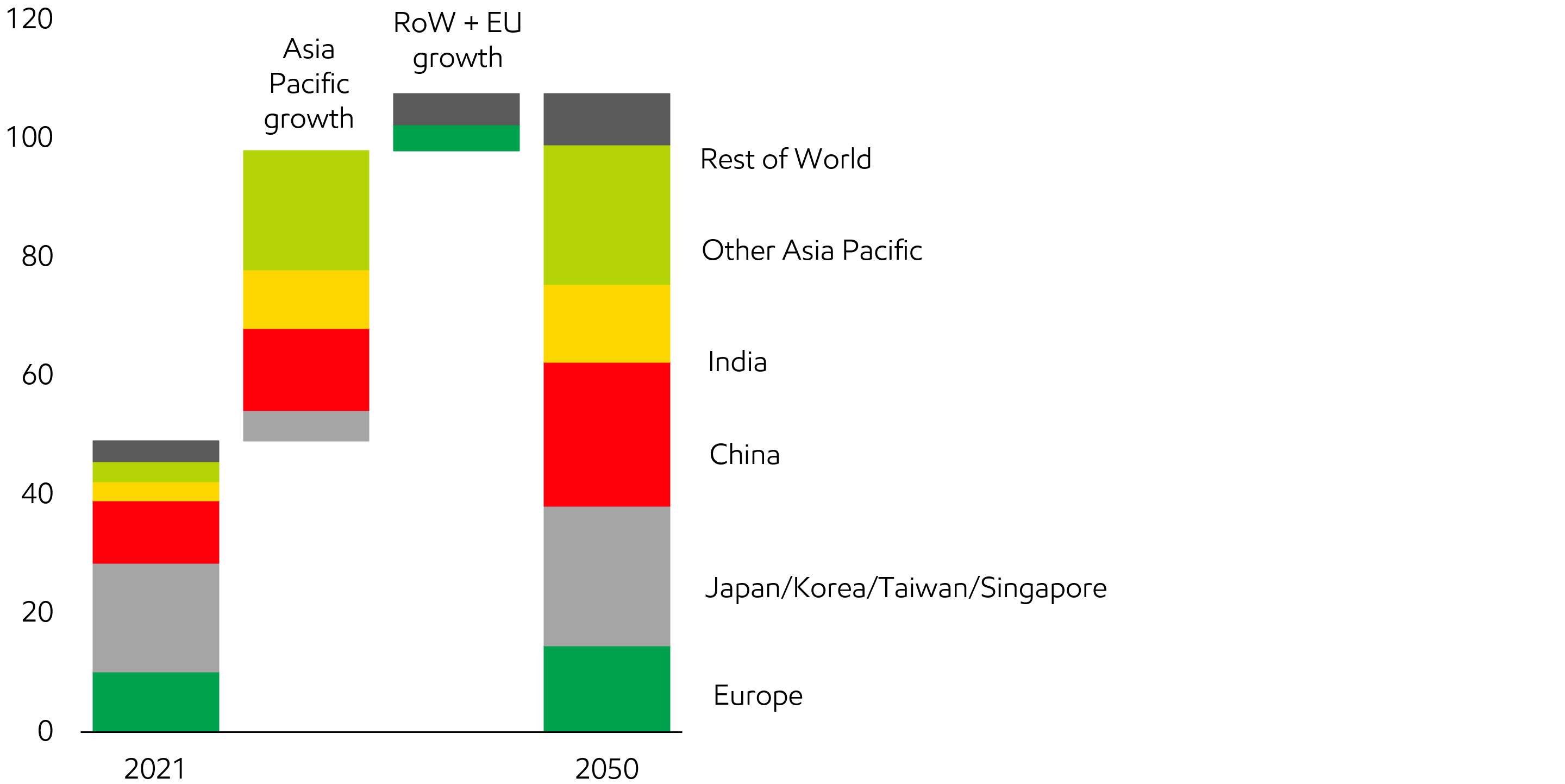
- In 2021, LNG trade met about 10% of global natural gas demand. By 2050, LNG trade will meet nearly 20% of the world’s natural gas needs.
- Asia Pacific absorbs about 85% of the growth in LNG from 2021 to 2050, helping the region to reduce its carbon intensity while sustaining economic growth.
- China’s ‘war on smog’ and ‘blue-sky’ policies have led to measurable improvements in urban air quality while boosting demand for LNG imports.
- India and other Asia Pacific importers are expected to look to LNG to supplement domestic natural gas production, often leveraging existing natural gas infrastructure.
- Europe is expected to tap competitive LNG to diversify its natural gas import portfolio
- In 2021, about 70% of LNG exports originated in Asia Pacific, the Middle East or Africa.
- North America’s LNG exports are projected to grow the most on an absolute basis as low-cost unconventional gas production prompts investment.
- East Africa, Qatar and Russia projects are expected to expand and diversify LNG exports.
- The LNG market is expected to remain highly competitive due to abundant natural gas resources and many aspiring exporters.
- The diversity and reliability of LNG supplies, combined with the flexibility to ship it where it is needed, make LNG a favorable choice for nations needing dependable, lower-emission energy sources to foster economic growth.
Diverse natural gas supplies underpin new LNG exports
Billion cubic feet per day
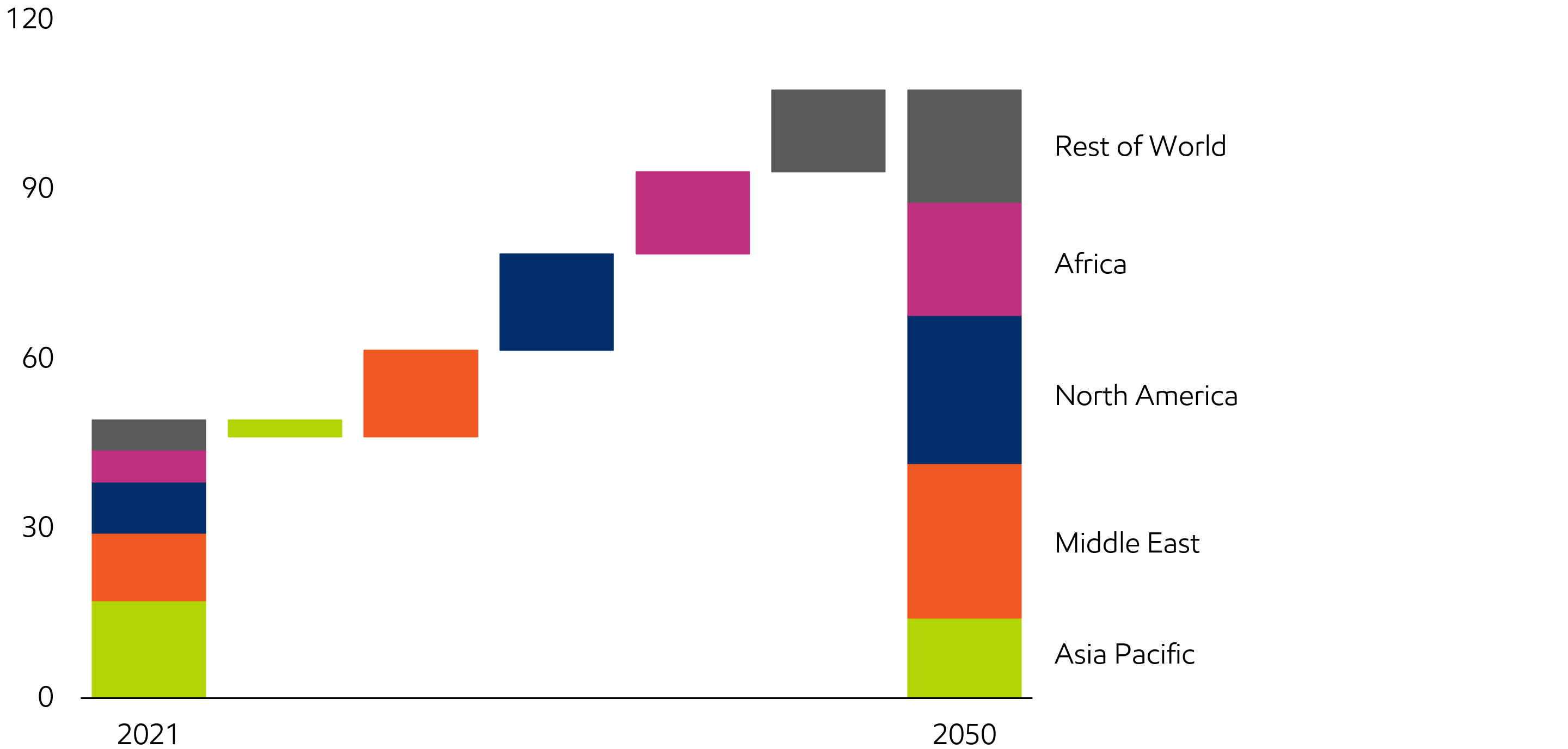
- In 2017, 85 percent of LNG exports originated in Asia Pacific, the Middle East or Africa
- North America’s LNG exports are projected to grow the most as low-cost unconventional gas production prompts investment
- East Africa, Qatar and Russia projects are expected to expand and diversify LNG exports
- The LNG market is expected to remain highly competitive due to abundant natural gas resources and many aspiring exporters
- The diversity and reliability of LNG supplies - combined with the flexibility to ship it where it is needed - make LNG a favorable choice for nations needing dependable, lower emissions energy sources to foster economic growth
Technology expands recoverable resources
World – thousand trillion cubic feet (TCF)
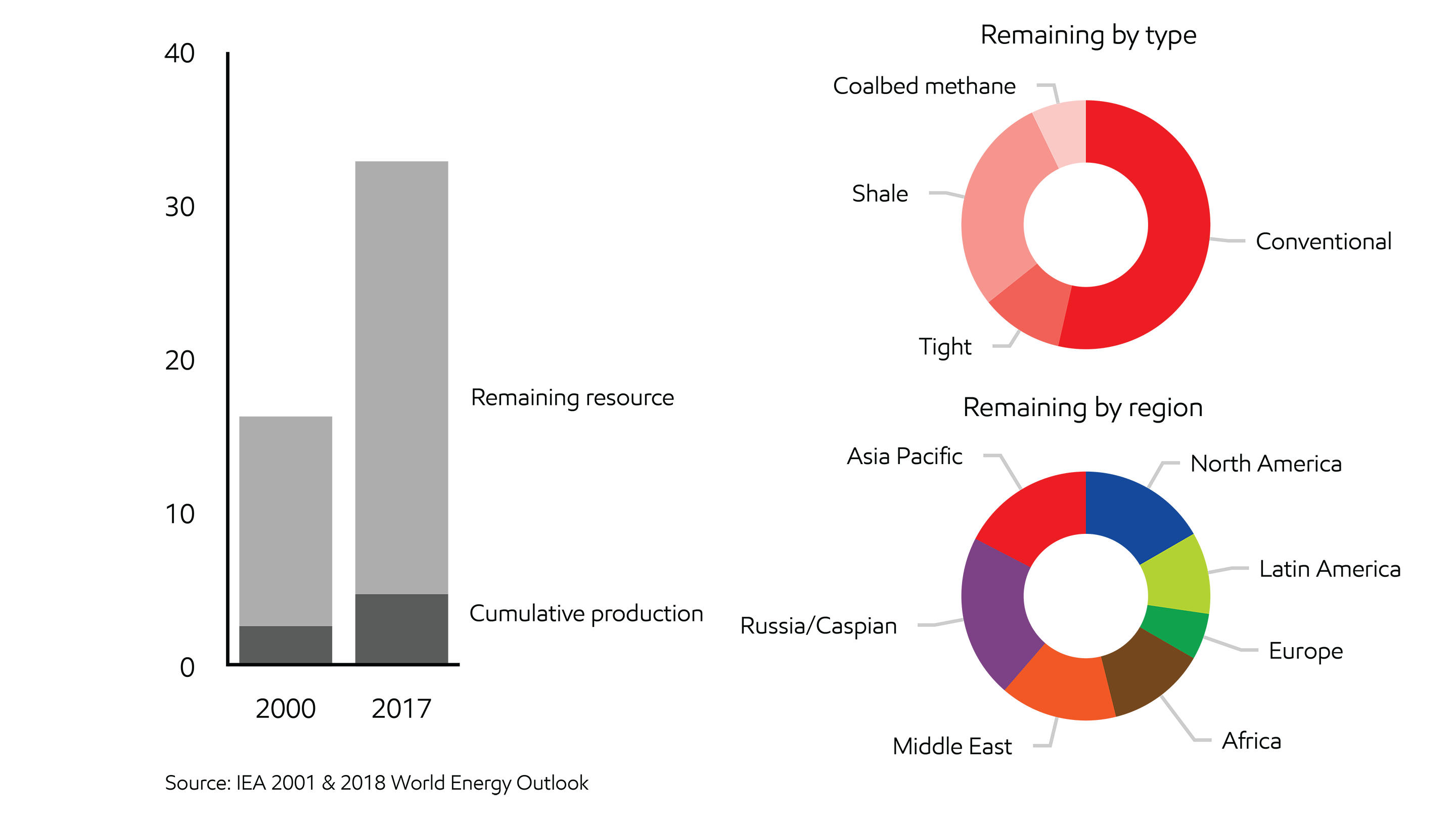
- Natural gas resource estimates keep rising as technology unlocks resources previously considered too difficult or costly to produce
- Less than 15 percent of recoverable natural gas resources have been produced
- Remaining natural gas resources can provide about 200 years of supply at current demand
- About 45 percent of remaining natural gas resources are from unconventional sources like shale gas, tight gas and coalbed methane
- Natural gas resources are geographically widespread
Visit energyfactor.com to learn more about some of the latest advances in the field and the lab that are helping meet tomorrow’s energy needs.
Related content

Emissions
Providing reliable, affordable energy to support prosperity and enhance living standards is coupled with the need to do so in ways that reduce impacts on the environment, including the risks of climate change. This is society’s dual challenge and ExxonMobil takes it seriously.
Pursuing a 2°C pathway
Many uncertainties exist concerning the future of energy demand and supply, including potential actions that societies may take to address the risks of climate change.
Outlook for Energy: A perspective to 2040
The 2019 Outlook for Energy is ExxonMobil’s latest view of energy demand and supply through 2040. For many years the Outlook has helped inform ExxonMobil’s long-term business strategies, investment plans and research programs.
Global fundamentals
Energy is essential for society’s progress. Economic expansion and improving access to energy enable longer, more productive lives for the growing global population.
Energy matters
With the world’s population estimated to reach more than 9 billion people in 2040, providing enough affordable energy to help improve global living standards is a significant challenge. We expect that continued progress, powered by human ingenuity and technology, will help make better lives possible, while appropriately addressing climate risks.